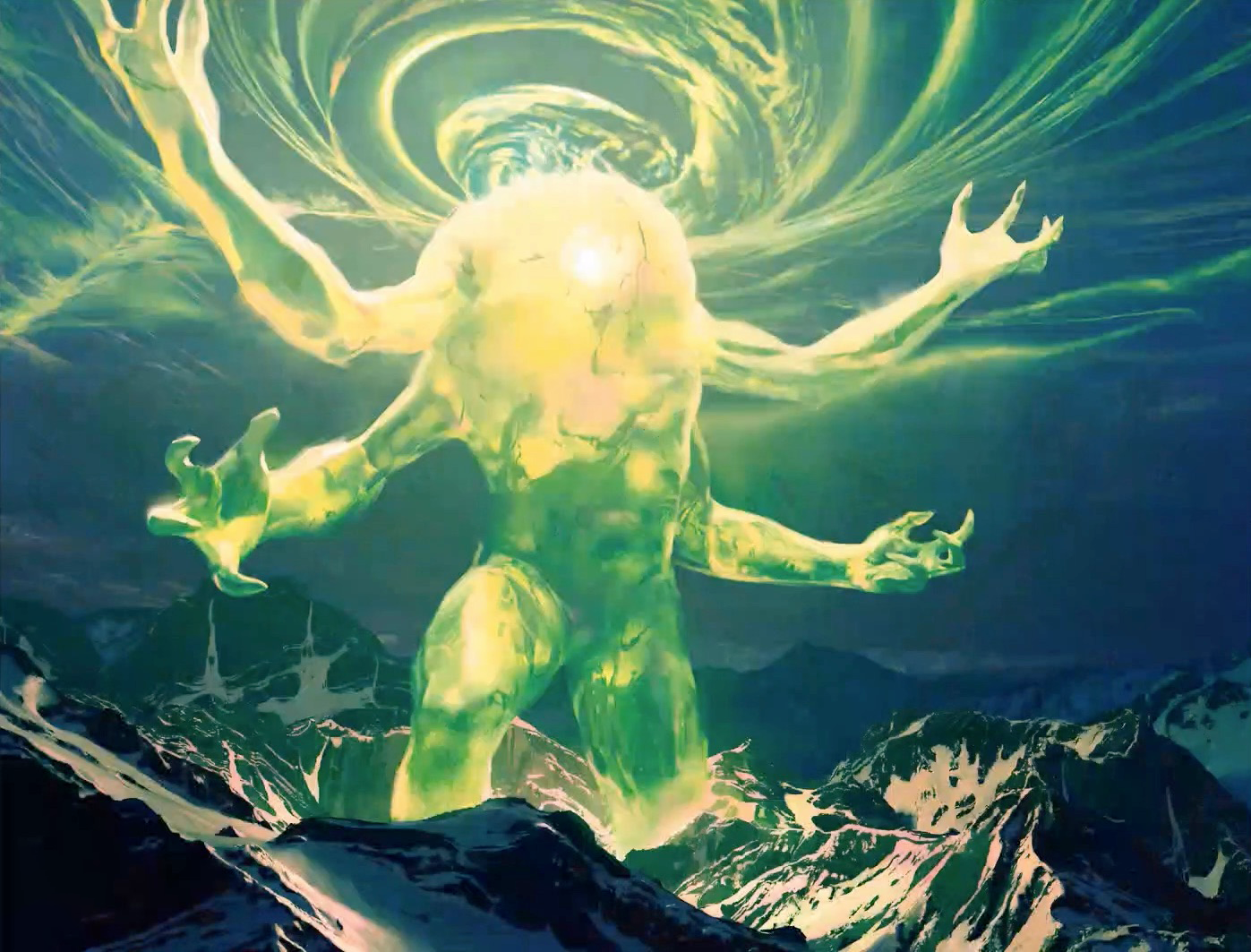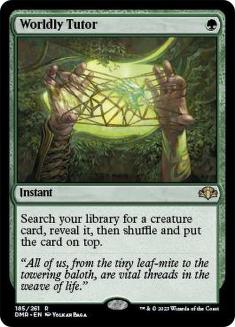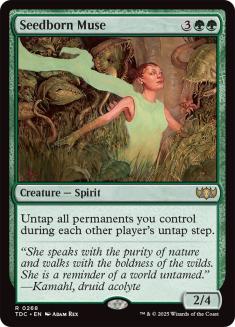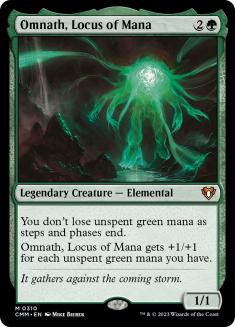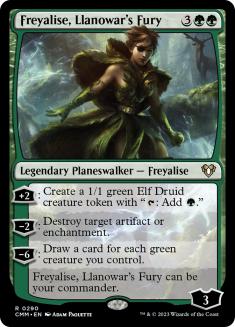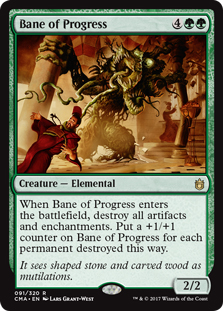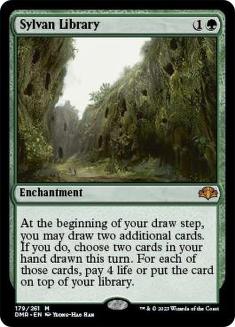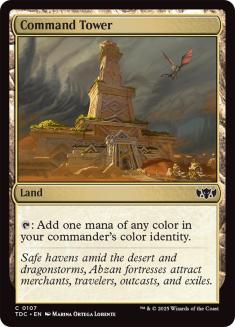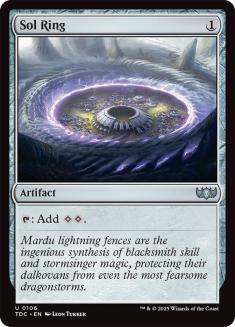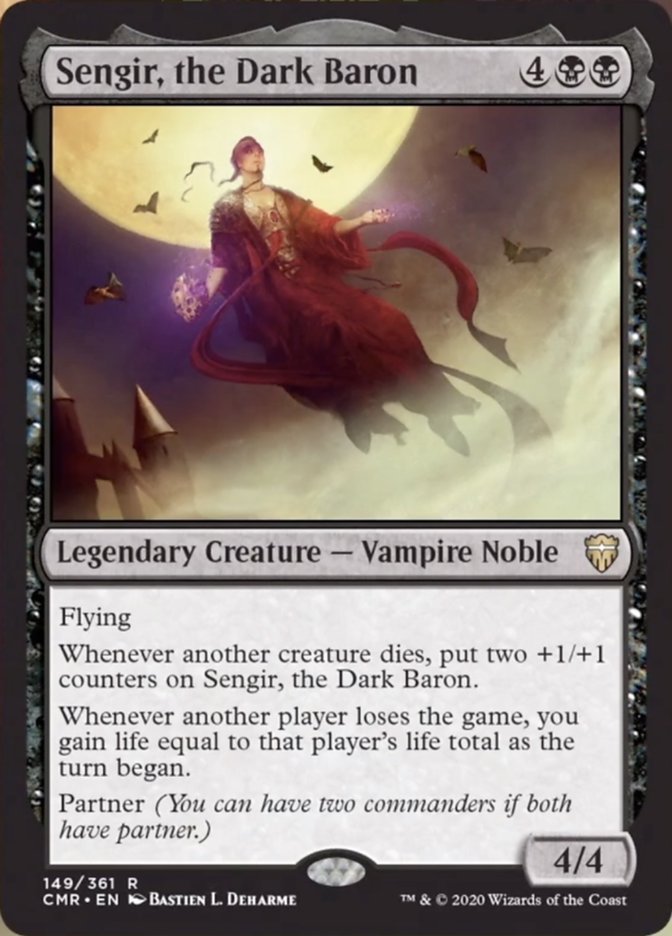Last weekend at CommandFest Online 2, a crack team of Studio X designers from Wizards of the Coast (WotC) gave us the first previews of November’s release of Commander Legends. Led by Commander Architect Gavin Verhey, along with designer (and Color Pie Council White representative) Ari Nieh and Commander Legends Lead Designer Jules Robbins, the panel offered an initial view into what to expect from the set and the mechanics surrounding it.
First up, however, was the pulse-pounding preview of all eight cards from Commander Collection: Green, on which Ari was the Lead Designer. What they showed got the collective pulses of Commander players everywhere fully revved. Each card has new art, artistically tied to Magic’s rich history.
Evoking Yisan, the Wanderer Bard, we’ll have access to a foil Worldly Tutor for the first time. The card is a staple across all ranges of play, with its straightforward but powerful effect: putting a creature from anywhere in your library to the top. It’s the kind of card you want whether you have a Lurking Predators trigger on the stack or you just want to get your favorite creature ready to cast.
Second up was one of the strongest cards in the format, Seedborn Muse. The art, which had been previewed back when the collection was first revealed, references the headpiece worn by Azusa, Lost but Seeking; the flavor text also has Azusa in it. Originally printed in Legions, then reprinted in Ninth Edition, Tenth Edition, Battlebond, and Commander 2019, foil versions of Seedborn Muse have nonetheless become precious properties. Its powerful effect of letting you untap all your permanents on everyone else’s turn have earned it a spot on the Can’t Get Angry List; if an opponent blows it up, salt is not allowed.
Unmistakable in its art, card three was Omnath, Locus of Mana. Omnath has seen updates in more recent sets, as Omnath, Locus of Rage (Battle for Zendikar) and Omnath, Locus of the Roil (Core Set 2020), and the community likes to speculate on what the next iteration of everyone’s favorite Elemental might look like, but it’s been a while since we’ve seen the OG in its initial printing in Worldwake (and then a reprint in From the Vault: Legends). This Omnath might not seem all that dangerous at first, but can get deadly from a commander damage hit in short order.
Freylise seemed to get the most ambivalent reaction of the revealed cards, but it seems like an exciting choice. It might not be as powerful as Seedborn Muse, but not everything is about power. Sometimes flexibility is what you need and Freyalise fits the bill. The +2 ability creates a mana Elf. The -2 provides a repeatable Naturalize. The -6 draws a pile of cards. It doesn’t have a big, splashy, game-winning ultimate, but it does have the bottom line of being able to be your commander. It’s an obvious leader of an Elf tribal deck, but I’m a fan of its possibilities as 1 of 99.
The card I might be most excited about, and that’s mostly because it’s another one heretofore unavailable in foil, is Bane of Progress. It’s an important card to exist in the format. I’m not sure that I’d call it necessarily powerful, but it’s certainly impactful. Artifacts and enchantments are very strong, and you have to pay attention if you’re using them and one of your opponents is in green—which is pretty likely. I’m not sure I’d call the card a format staple, but it’s a card that you simply have to recognize and consider the existence of. The chompy art is just a bonus.
The sixth and final actually green card is Sylvan Library. This might be the coolest of all the arts. It portrays Reki, History of Kamigawa, who if you remember, has the history of his culture tattooed on himself. Hanging out in the forest makes him an actual sylvan library. This has the Vorthos in me very, very happy. Although it’s been reprinted multiple times since its original appearance in Legends, the price of the card has remained high. I doubt that its print here impacts that very much, unfortunately. It will remain an extremely high-demand card.
Some folks might think inclusion of the Command Tower in this collection a little cheaty, but I’m all for it. The green-tinged treatment on the art means that it’s likely going to be in the other colors as well, meaning you can get eventually the appropriately-colored ones to go into your decks. This fills me with a kind of joy I didn’t know I had in me. The art is new, although it’s evocative of both the original Ryan Yee and Commander’s Arsenal Adam Paquette versions.
If you were ever in doubt that Sol Ring were a possibility for banning, hopefully this inclusion has put that to rest. The card isn’t going anywhere and banning it has never been a serious consideration. It will remain the standard bearer for the format. This treatment is stunning and the fact that we’ll have them available in foil will make all of us magpies quite pleased. There’s not too much that hasn’t already been said about the card, so I won’t belabor any points. Like with Command Tower, I look forward to color-coding them to decks, although what to do in the case of three- and four-color decks is going to need some deep consideration.
The other big reveal, right at the end of the panel, was completing of the cycle of Battlebond lands, which Gavin likes to call the “crowd lands.” This brought a collective cheer from the chat. The crowd lands are already extremely popular, so adding the enemy-color ones makes a great deal of sense. I don’t think that Commander Legends will need any help in boosting sales, but the crowd lands certainly aren’t going to hurt anything.
Commander Legends is all about Commander meets Draft. Or Draft meets Commander. Either way, it’s something quite new and exciting, a method of getting Commander product into the wild without having it be part of a preconstructed deck cycle. The relevant thing here is that the focus of this product is to get the feel of Commander in a draft environment, not simply to have Commander, just draftable. Just like normal Commander, we want Commander Draft to be the best that it can be on its own terms.
The draft rules have some divergence from the normal rules of Commander. The Commander Rules Committee (RC) was consulted during this; we even wrote a white paper on the elements of the format that we were committed to not wanting to change and those that were more flexible.
There are two major changes in Commander Draft. The first is to a 60-card deck. Forcing people to draft 100-card decks from booster product might get pretty tedious. Dropping it to 60 will speed up a draft and generally make the decks tighter and more focused. The second change is that the singleton rule doesn’t apply. Drafting multiple copies of a really good card and being able to play only one is already a feel-bad moment. Having to pass a really good card to someone else because you’ve already drafted one has to feel pretty terrible.
The most important core elements of Commander have been maintained. To wit, color identity still applies and we still have commander damage. From our perspective, it’s not Commander without both of these foundational elements, and it would have taken a significant tectonic shift to get us off of them. We were willing to be a little more flexible on the life total, but are happy that it stayed at 40.
The main problem they wanted to solve in design was that of each deck’s commander—making sure that players got something playable in their color identity. How they did it this time was re-introducing the partner mechanic. This is potentially dangerous ground to tread on.
When the folks in Studio X (back in those days, R&D) first shared with the RC the idea, our advice boiled down to two words: Be careful. From what I’ve seen of the Commander Legends cards, they’ve both taken this advice and learned from some faltering steps in Commander 2016. The most significant thing is that all the cards that have partner are mono-colored. This is less likely to lead to broken combos of partners. While the partners in Commander 2016 were designed to solve the four-color commander problem, there’s no such concern here. It remains to be seen how this will work out in the draft, but mono-color partners let loose in the constructed environment are far less of a threat to the format as a whole than the two-color ones. We’ll have to judge individual cards on their own merits, but the setup is potentially less problematic.
The other solution to the draft problem is putting a failsafe commander into the packs in the land slot. Prismatic Piper is a five mana 3/3 legendary Shapeshifter which, if you play it as your commander, allows you to choose a color before the game begins. If you do, it’s that color. It also has partner. If you’ve drafted a color that you didn’t get the right commander for, Prismatic Piper is there for you to add the color. It’s really only relevant in Draft and only as the backup plan; it’s an elegant solution to a potential problem in the Draft format. For Constructed, there will always be better options.
Of course, the most significant part of Commander Legends is going to be the cards that’ll be included. Gavin mentioned that unlike other products, they’re not trying to craft a narrative of any kind here. The cards in the set’s flavor will pull from any place and any time in Magic’s long history. That’s the format, though. You’re going to see cards from every era of Magic in Commander decks, and the same will be true for Commander Legends. The one they revealed takes a long trip in the Wayback Machine.
For a character so important to the lore of Magic, the Homelands card is pretty much unplayable. The new version is something else. It has partner, consistent with the mono-color legendary creature theme of the set. It’s a 4/4 flyer for six mana, already solid. Its abilities distinguish it.
The first is a triggered ability which puts two +1/+1 counters on Sengir, the Dark Baron whenever another creature dies. Due to the recent rules change, this can also be commander Sengir is partnered with. This may become somewhat silly when partnered with Reyhan, Last of the Abzan. Being in black, you know that you want creatures to die, and you’re usually willing to make it some of your own.
The second is going to require paying attention and is unlike any ability we’ve seen before (the closest is probably Blood Tyrant). It’s an ability that triggers when another player loses the game. You gain life equal to the life total of that player when the turn started. This means you’ll have to pay attention to all players’ beginning of turn life totals, since you never know what’s going to happen in a Commander game. This is potentially a huge life point gain, since sometimes the only way to kill someone (like with Oloro, Ageless Ascetic decks) is via commander damage.
My somewhat dreamy scenario with Sengir is to be playing it with white. The relatively common scenario of someone overrunning the table with Craterhoof Behemoth or Pathbreaker Ibex happens. The Sengir player, who is already playing Serra Avatar, plays Angel’s Grace, meaning they can’t lose. When the other players lose, they get both life total bumps, then swing on the crack-back with the now-immense Serra Avatar. Yes, it’s magical Christmas land, and it would be amazing. The point is that Sengir, the Dark Baron will be awash with compelling possibilities.
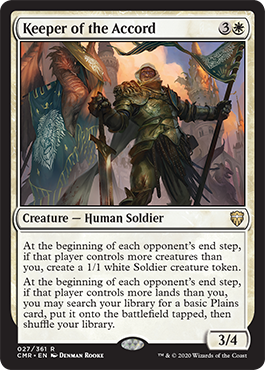
The other exciting card previewed was non-legendary and represents movement in Studio X thinking about the color white. White has been the color of balance and equilibrium (not necessarily meaning the cards of those names, mind you) and Keeper of the Accord is a great representation. At the beginning of each opponent’s end step, it has two triggers. On the first, if they have more creatures than you, you get a 1/1 Human Soldier. More significant is the second. If they have more lands than you, you can fetch up a basic Plains.
When paired with non-green colors, white tends to get behind on land counts (which is why Land Tax is so popular). Keeper of the Accord will help solve that without getting too far out of hand. Because it gets only Plains, it’s not there for fixing. It’s about quantity and not quality. Still, it’s going to be a card that you see a fair amount in the format.
An additional highlight of the panel is the alternate foiling they revealed. In addition to the new legendary creatures printed in the set, 32 legendary creatures will be reprinted. Each of them will appear only in the gorgeous new etched foil treatment, a burnished, less glossy method that almost gives the card a 3D feel. They’ll randomly appear in the normal boosters; you’ll get at least one in every Collector Booster.
Commander Legends is a much-hyped set for many good reasons. It’s a new way of thinking about how to get compelling cards into the hands of Commander players. While we might approach the huge influx of legendary creatures with some trepidation, it looks like the design and development teams have heeded the RC’s be careful warning. This new era, not just of mechanics, but of thought, opens a thrilling future for players of the game’s most popular format.

